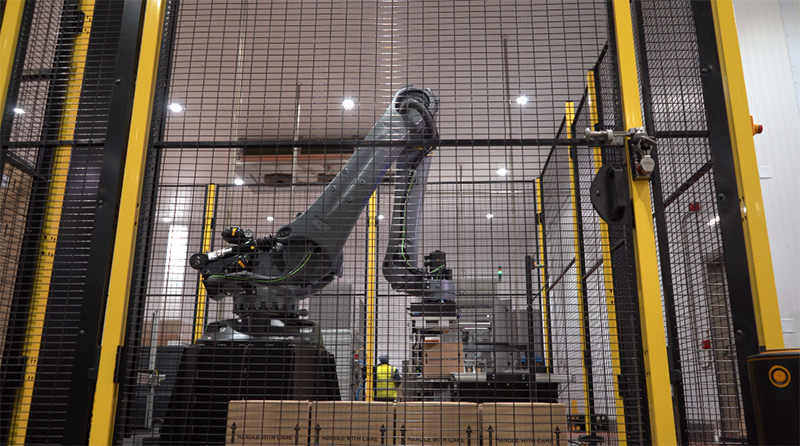
In the ever-evolving landscape of production, warehousing and logistics, two priorities stand out: maximising efficiency and ensuring worker safety. Amidst the push for technological advancements, easy program and auto programming palletiser systems have revolutionised material handling and storage. This article explores the intricacies of palletising, its impact on operational efficiency, and its crucial role in mitigating Repetitive Strain Injury (RSI) among workers.
What is Palletising?
Palletising is the process of stacking products onto a pallet for storage or transportation. Often this task is performed manually, leading to inefficiencies and significant risks for workers. However, with the advent of easy program and auto programming palletiser systems, palletising has undergone a significant transformation.
Types of Palletising
Palletising methods can be broadly categorised into manual, semi-automatic, and fully automatic, each offering varying levels of efficiency, precision, and automation. Understanding these different systems is essential for determining the most suitable approach for specific operational needs. Here’s a closer look at each type:
- Manual Palletising:
- Involves workers stacking products onto pallets by hand.
- Prone to human error, physical strain, and inefficiencies.
- High risk of RSI due to repetitive lifting and stacking.
- Semi-Automatic Palletising:
- Combines human labour with machinery.
- Machines assist with heavy lifting while workers handle the placement of goods.
- Reduces physical strain but still involves repetitive tasks.
- Fully Automatic Palletising:
- Utilises robotic arms and automated systems to manage the entire process.
- Minimises human involvement, ensuring consistency, precision, and efficiency.
- Elimination of RSI risk due to no manual input.
Enhancing Efficiency through Automated Palletising
The implementation of automated palletising systems brings numerous advantages that significantly enhance operational efficiency:
- Increased Throughput:
- Robots can operate continuously without the need for breaks, dramatically increasing productivity.
- Ability to handle higher volumes of products in shorter time frames.
- Consistency and Precision:
- Automated systems ensure uniform stacking, optimise pallet stacking patterns and minimise the risk of product damage during transportation.
- Enhanced accuracy in handling delicate or perishable items.
- Cost Reduction:
- Although the initial investment in automated systems can be substantial, the long-term savings from reduced labour costs, decreased product damage, and improved operational efficiency are significant. This downloadable automation payback calculator will enable you to calculate the likely payback time of your investment. www.granta-automation.co.uk/automation-project-payback-calculator
- Reduced need for overtime pay and removes the risk of worker injury-related costs.
- Adaptability:
- Traditional palletiser systems require 1-2 days to program and set up a stack pattern for a new product. They also require a skilled robot programmer, which can be costly and inconvenient.
- Easy programming palletiser systems only take 5 minutes to set up a new stack pattern, and can be programmed by anyone.
- Auto programming palletisers scan the product using a laser measuring system and then automatically create stack patterns without the need for human input.
Addressing Repetitive Strain Injury (RSI)
Repetitive Strain Injury (RSI) is a pervasive issue in production and warehousing environments, resulting from repetitive motions and prolonged physical exertion. Manual palletising, in particular, is a high-risk task due to the constant lifting, twisting, and stacking required. RSI can lead to chronic pain, decreased productivity, and increased healthcare costs. This downloadable RSI calculator will enable you to calculate the risk of RSI in your palletising process. www.granta-automation.co.uk/repetitive-strain-injury-assessment-tool-download
Mitigating RSI through Automated Palletising
One of the most significant benefits of automated palletising systems is their potential to reduce the incidence of Repetitive Strain Injury (RSI) among workers. By minimising or eliminating the physical demands of manual stacking, these systems help create a safer and more ergonomic working environment. Key strategies for mitigating RSI through automated palletising include:
- Minimised Manual Handling:
Automated systems significantly reduce or eliminate the need for manual stacking, thus lowering the exposure of workers to repetitive tasks that can lead to RSI. - Ergonomic Improvements:
Semi-automatic systems can be designed to enhance ergonomic conditions, allowing workers to operate at comfortable heights and positions, reducing physical strain. - Task Rotation:
Automation allows for better allocation of human resources, enabling workers to engage in a variety of tasks, thereby reducing the risk of repetitive motion injuries through varied physical activities. - Reduced Physical Strain:
Machines handle the heavy lifting and repetitive movements, eliminating the physical strain on workers and removing the likelihood of injuries.
The integration of automated palletising systems in production, warehousing and logistics represents a significant leap forward in both operational efficiency and worker safety. By reducing reliance on manual labour and minimising repetitive tasks, these systems not only enhance productivity but also play a crucial role in mitigating the risks associated with Repetitive Strain Injury (RSI). As technology continues to advance, the adoption of automated palletising will undoubtedly become more widespread, setting new standards for operational excellence and worker well-being.
If you would like to discuss your specific palletising requirements and the best methods of automating your process, please contact us on 01223 499488 or helpline@granta-automation.co.uk and we will be happy to help.








Warning: Undefined variable $aria_req in /var/www/granta-automation.co.uk/news/wp-content/themes/twentyten/comments.php on line 81
Warning: Undefined variable $aria_req in /var/www/granta-automation.co.uk/news/wp-content/themes/twentyten/comments.php on line 86